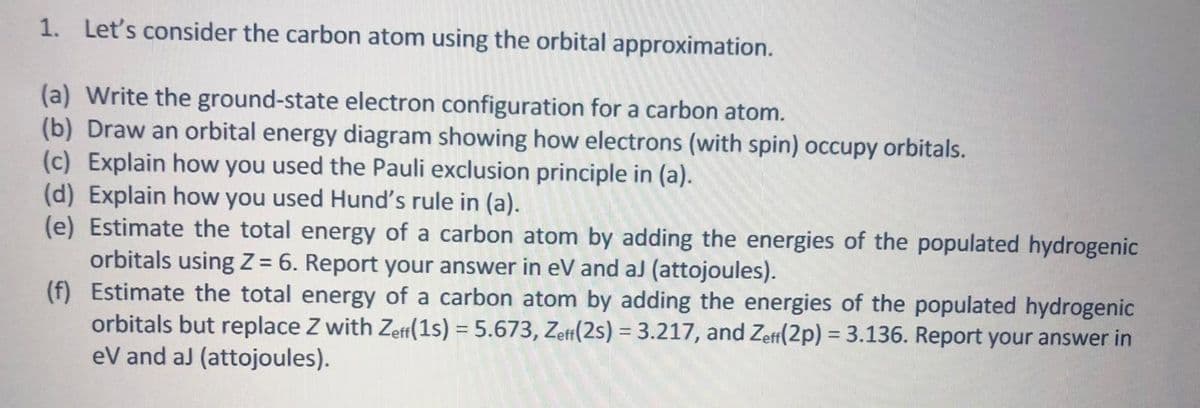1. Let's consider the carbon atom using the orbital approximation. (a) Write the ground-state electron configuration for a carbon atom. (b) Draw an orbital energy diagram showing how electrons (with spin) occupy orbitals. (c) Explain how you used the Pauli exclusion principle in (a).
1. Let's consider the carbon atom using the orbital approximation. (a) Write the ground-state electron configuration for a carbon atom. (b) Draw an orbital energy diagram showing how electrons (with spin) occupy orbitals. (c) Explain how you used the Pauli exclusion principle in (a).
Physical Chemistry
2nd Edition
ISBN:9781133958437
Author:Ball, David W. (david Warren), BAER, Tomas
Publisher:Ball, David W. (david Warren), BAER, Tomas
Chapter12: Atoms And Molecules
Section: Chapter Questions
Problem 12.12E: Are mathematical expressions for the following potential energies positive or negative? Explain why...
Related questions
Question
can you solve it

Transcribed Image Text:1. Let's consider the carbon atom using the orbital approximation.
(a) Write the ground-state electron configuration for a carbon atom.
(b) Draw an orbital energy diagram showing how electrons (with spin) occupy orbitals.
(c) Explain how you used the Pauli exclusion principle in (a).
(d) Explain how you used Hund's rule in (a).
(e) Estimate the total energy of a carbon atom by adding the energies of the populated hydrogenic
orbitals using Z = 6. Report your answer in eV and aJ (attojoules).
(f) Estimate the total energy of a carbon atom by adding the energies of the populated hydrogenic
orbitals but replace Z with Zeff(1s) = 5.673, Zeff(2s) = 3.217, and Zetf(2p) = 3.136. Report your answer in
eV and aJ (attojoules).
Expert Solution
Step 1
Solution
the standard notation usually yields extended negatron configurations (especially for parts having a comparatively giant atomic number). In such cases, Associate in Nursing abbreviated or condensed notation could also be used rather than the quality notation. within the abbreviated notation, the sequence of fully stuffed subshells that correspond to the electronic configuration of a inert gas is replaced with the image of that inert gas in sq. brackets. Therefore, the abbreviated negatron configuration of metal is [Ne]3s1 (the negatron configuration of noble gas is 1s22s22p6, which might be abbreviated to [He]2s22p6).
Trending now
This is a popular solution!
Step by step
Solved in 2 steps with 1 images

Knowledge Booster
Learn more about
Need a deep-dive on the concept behind this application? Look no further. Learn more about this topic, chemistry and related others by exploring similar questions and additional content below.Recommended textbooks for you

Physical Chemistry
Chemistry
ISBN:
9781133958437
Author:
Ball, David W. (david Warren), BAER, Tomas
Publisher:
Wadsworth Cengage Learning,

World of Chemistry, 3rd edition
Chemistry
ISBN:
9781133109655
Author:
Steven S. Zumdahl, Susan L. Zumdahl, Donald J. DeCoste
Publisher:
Brooks / Cole / Cengage Learning

Chemistry
Chemistry
ISBN:
9781305957404
Author:
Steven S. Zumdahl, Susan A. Zumdahl, Donald J. DeCoste
Publisher:
Cengage Learning

Physical Chemistry
Chemistry
ISBN:
9781133958437
Author:
Ball, David W. (david Warren), BAER, Tomas
Publisher:
Wadsworth Cengage Learning,

World of Chemistry, 3rd edition
Chemistry
ISBN:
9781133109655
Author:
Steven S. Zumdahl, Susan L. Zumdahl, Donald J. DeCoste
Publisher:
Brooks / Cole / Cengage Learning

Chemistry
Chemistry
ISBN:
9781305957404
Author:
Steven S. Zumdahl, Susan A. Zumdahl, Donald J. DeCoste
Publisher:
Cengage Learning

Chemistry: An Atoms First Approach
Chemistry
ISBN:
9781305079243
Author:
Steven S. Zumdahl, Susan A. Zumdahl
Publisher:
Cengage Learning


Principles of Modern Chemistry
Chemistry
ISBN:
9781305079113
Author:
David W. Oxtoby, H. Pat Gillis, Laurie J. Butler
Publisher:
Cengage Learning